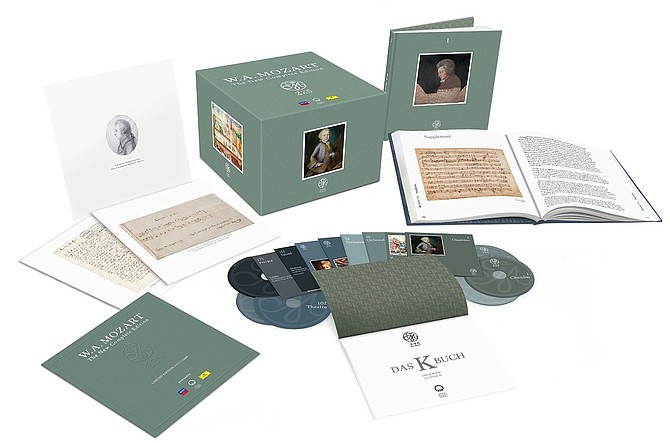 Facebook
Facebook
 X
X
 Instagram
Instagram
 TikTok
TikTok
 Youtube
Youtube

Next year will be the 225th anniversary of Mozart’s death. To celebrate/capitalize there is a new complete edition of Mozart’s music being released in the form of a 200 disc box set. It’s called W. A. Mozart the New Complete Edition 225 and the price on Amazon is $479.
Would you believe it is to be released in October? October is the new November of Christmas shopping.
Sounds like a good chunk of change until we do the math: $479 divided by 200 discs comes out to $2.40 per disc. In the olden days CDs in a box set usually came out to about $10 to $15 per disc. This thing is a bargain.
The set bears the logos of Decca and Deutsche Grammophon, but there are 18 labels represented. As we might imagine, the artists are collected from the A-lists of these venerable recording institutions.
There are current names such as Barenboim, Terfel, and Nézet-Séguin (new music director of the Met). There are legendary names such as Solti, Böhm, and Wunderlich.
Decca and DG were on the sidelines in 1991 when Philips issued a complete set of works in celebration of the 200th anniversary of Mozart’s death. Mozart 225 surpasses the Phillips collection by including tons of material that has come to light in the past 25 years.
Joining the legion of CDs are two hardback books full of analysis and context. The entire collection is quite academic. It's like receiving a musicology degree in a box.
Mozart wrote arrangements of pieces by Handel and Bach. They’re in the set. There are over 100 pieces of music that are fragments or completions by other composers. They’re in the set. Alternative performances? They’re in the set.
What is an alternative performance? It’s difficult to tell which is considered the un-alternative performance but there are, for instance, two complete recordings of Le nozze di Figaro.
There is one conducted by Arnold Östman and a “classic performance” conducted by Erich Kleiber. The Östman is what we would call a “period performance,” which tries to replicate the practices of the 18th Century. The Kleiber is a mid-20th-century approach that we might be tempted to call “traditional.”
Beyond the two complete Figaro’s there are several arias and scenes that double or triple up on sections from the complete opera recordings.
The orchestral section gets a bump from supplemental performances as well. There are two recordings of all of Mozart’s most popular concertos and symphonies. The same format applies. There is a period performance and a traditional.
As I said, it’s quite academic.


Next year will be the 225th anniversary of Mozart’s death. To celebrate/capitalize there is a new complete edition of Mozart’s music being released in the form of a 200 disc box set. It’s called W. A. Mozart the New Complete Edition 225 and the price on Amazon is $479.
Would you believe it is to be released in October? October is the new November of Christmas shopping.
Sounds like a good chunk of change until we do the math: $479 divided by 200 discs comes out to $2.40 per disc. In the olden days CDs in a box set usually came out to about $10 to $15 per disc. This thing is a bargain.
The set bears the logos of Decca and Deutsche Grammophon, but there are 18 labels represented. As we might imagine, the artists are collected from the A-lists of these venerable recording institutions.
There are current names such as Barenboim, Terfel, and Nézet-Séguin (new music director of the Met). There are legendary names such as Solti, Böhm, and Wunderlich.
Decca and DG were on the sidelines in 1991 when Philips issued a complete set of works in celebration of the 200th anniversary of Mozart’s death. Mozart 225 surpasses the Phillips collection by including tons of material that has come to light in the past 25 years.
Joining the legion of CDs are two hardback books full of analysis and context. The entire collection is quite academic. It's like receiving a musicology degree in a box.
Mozart wrote arrangements of pieces by Handel and Bach. They’re in the set. There are over 100 pieces of music that are fragments or completions by other composers. They’re in the set. Alternative performances? They’re in the set.
What is an alternative performance? It’s difficult to tell which is considered the un-alternative performance but there are, for instance, two complete recordings of Le nozze di Figaro.
There is one conducted by Arnold Östman and a “classic performance” conducted by Erich Kleiber. The Östman is what we would call a “period performance,” which tries to replicate the practices of the 18th Century. The Kleiber is a mid-20th-century approach that we might be tempted to call “traditional.”
Beyond the two complete Figaro’s there are several arias and scenes that double or triple up on sections from the complete opera recordings.
The orchestral section gets a bump from supplemental performances as well. There are two recordings of all of Mozart’s most popular concertos and symphonies. The same format applies. There is a period performance and a traditional.
As I said, it’s quite academic.
Comments